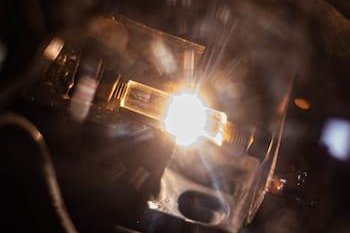Scientists can successfully convert carbon-containing waste materials into graphene flakes by rapidly heating the material to 3,000 degrees Kelvin, or approximately 5,000 degrees Fahrenheit. Photo by Jeff Fitlow / Rice University
Jan. 28 (UPI) -- Food waste and plastic garbage can now be converted into graphene, thanks to a new processing technique developed by chemical engineers at Rice University.
"This is a big deal," Rice chemist James Tour said in a news release. "The world throws out 30 percent to 40 percent of all food, because it goes bad, and plastic waste is of worldwide concern. We've already proven that any solid carbon-based matter, including mixed plastic waste and rubber tires, can be turned into graphene."
Graphene is a strong, durable and highly conductive material composed of 2D sheets of carbon atoms. In each graphene sheet, the carbon atoms form a hexagonal lattice, or honeycomb-like, pattern.
In the lab, researchers succeeded in turning all kinds of carbon-containing materials into flash graphene -- everything from coal to wood clippings. To convert the material into graphene, researchers heat it to a temperature 3,000 degrees Kelvin. The process essentially speeds up the natural processes that forge carbon deep beneath the surface of the Earth. The rapid heating results in flakes of pristine carbon.
The process is simple and cheap, and scientists estimate it can be used to lessen the carbon footprint of cement.
"By strengthening concrete with graphene, we could use less concrete for building, and it would cost less to manufacture and less to transport," Tour said. "Essentially, we're trapping greenhouse gases like carbon dioxide and methane that waste food would have emitted in landfills. We are converting those carbons into graphene and adding that graphene to concrete, thereby lowering the amount of carbon dioxide generated in concrete manufacture. It's a win-win environmental scenario using graphene."
Previously, the expense of graphene production prevented its use in applications like cement-strengthening. Now, scientists estimate flash graphene could be used to enhance a variety of materials.
The technology builds on previous graphene-processing techniques. Most importantly, the new heating technique yields "turbostratic" graphene, featuring misaligned layers that are easy to separate.
"A-B stacked graphene from other processes, like exfoliation of graphite, is very hard to pull apart," Tour said. "The layers adhere strongly together. But turbostratic graphene is much easier to work with because the adhesion between layers is much lower. They just come apart in solution or upon blending in composites."
In the future, scientists hope to make the production process -- described this week in the journal Nature -- even more economical and eco-friendly by capturing the gaseous byproduct emitted during the flashing heating process.
"When this process is industrialized, elements like oxygen and nitrogen that exit the flash reactor can all be trapped as small molecules because they have value," Tour said.
Compared to most graphene manufacturing technologies, there is very little waste to capture. Most of the energy is focused into the material.
"All the excess energy comes out as light, in a very bright flash, and because there aren't any solvents, it's a super clean process," Tour said.
Scientists are now considering ways to scale-up their flash graphene technology, as there are a variety of markets that could use flash graphene. The material could be incorporated into plastic, metals, plywood, concrete and other building materials.















